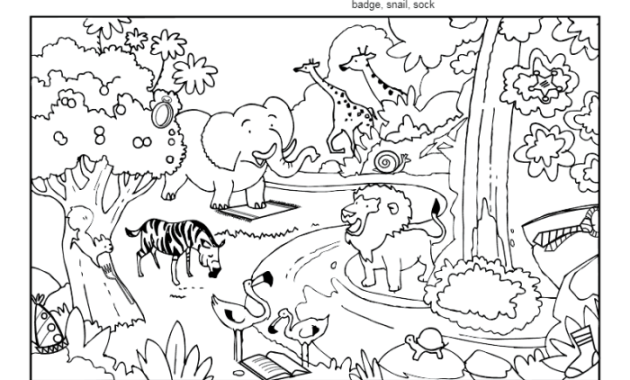Design of a “God Created Animals” Coloring Page: God Created Animals Coloring Page

God created animals coloring page – A successful “God Created Animals” coloring page requires careful consideration of design elements to ensure both visual appeal and age-appropriateness. The design should be engaging for children while respectfully reflecting the biblical narrative of creation. Several design approaches can achieve this goal, each with its own strengths.
Diverse Species Representation, God created animals coloring page
The coloring page should feature a variety of animals, showcasing the biodiversity of God’s creation. Inclusion of animals from different continents and habitats fosters a broader understanding of the natural world. The animals should be depicted in a way that is both realistic and appealing to children, avoiding overly complex details that might be difficult for young children to color.
For example, a vibrant lion with a simple mane, a playful monkey swinging from a branch, and a graceful giraffe reaching for leaves all offer opportunities for creative coloring. The selection should include both common and less familiar animals, sparking curiosity and expanding children’s knowledge of the animal kingdom.
Habitat-Based Grouping
Organizing animals by habitat is an effective way to present the diversity of creation. This approach allows for thematic cohesion and provides a context for the animals’ existence. A design could feature three distinct sections: a lush jungle scene with monkeys, parrots, and jaguars; a vibrant coral reef with colorful fish and sea turtles; and a sun-drenched desert landscape with camels, scorpions, and cacti.
This method encourages children to explore the different environments God created and the unique creatures inhabiting each.
Biblical Scene Depiction
Incorporating a biblical scene into the coloring page adds a deeper layer of meaning. A depiction of God creating animals, perhaps with Adam and Eve observing, could be a central focus. The style should be simple and evocative, focusing on the essential elements of the scene. For example, God’s hand extending towards a pair of newly created animals, or a gentle scene with Adam and Eve naming the animals, would create a visually engaging and theologically appropriate element.
The scene should be integrated seamlessly with the animal illustrations, avoiding overcrowding or confusion.
Sample Layout Using an HTML Table
The following table illustrates a potential layout for a four-column coloring page, suitable for responsive design. Each column represents a different habitat or theme. The images are described, not displayed.
| Jungle Scene: A vibrant green jungle with a monkey swinging from a vine, a toucan perched on a branch, and a jaguar resting beneath a large leaf. | Ocean Scene: A coral reef teeming with life, featuring a brightly colored clownfish amongst anemones, a sea turtle swimming gracefully, and a playful dolphin leaping from the water. | Desert Scene: A sandy desert landscape with a camel caravan traversing the dunes, a scorpion hiding amongst rocks, and a majestic eagle soaring overhead. | Creation Scene: God’s hand gently reaching out to a pair of newly created deer, with Adam and Eve observing in the background. Simple, clear lines would make coloring easier. |
Exploring the wonder of God’s creation through a “God created animals coloring page” offers a delightful way to engage with nature’s diversity. For a deeper understanding of the animals themselves, you might find the detailed illustrations in an animal anatomy coloring book particularly enriching. This allows for a more comprehensive appreciation of the intricate designs present in God’s animal kingdom, further enhancing the coloring page experience.

